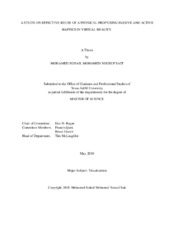| dc.description.abstract | In virtual environments, the user cannot touch or feel the virtual objects. A straightforward way to solve this problem is to set up motion-tracked real objects that represent the virtual objects. An ideal proxy object must match a virtual object in position, geometry, surface texture, motion and weight. However, creating such a physical setup on a large scale can be a challenging task due to limited physical tracking spaces and the cost involved in building the infrastructure. Hence, the reuse of the physical prop or surface is essential. Our research focuses on studying the efficient reuse of a physical prop to map multiple virtual objects, interactions, and object properties. An interaction-based hand redirection technique was developed and implemented in a VR puzzle game/study to understand general usability and user preference, in comparison with a non-haptic case. In the study, there were cases where the position of the passive haptic object was moving outside the user’s comfortable area of reach, making it harder to re-apply the hand redirection technique, without resetting the position of the physical prop. One possible solution was to scale virtual object motion to eliminate the problem of resetting, but the amount of scaling needed varied for different interaction types. Hence, a second user study was conducted to investigate the human perception of scaled virtual interactions in object manipulation tasks. Results from the work reported in the thesis showed that it could be difficult to detect a moderate amount of scaling, and this outcome is favorable in varying the mapping between the real and virtual worlds. To further learn the reuse and role of props in representing other object properties such as weight, we built a light-weight vibrotactile haptic system and tested its influence on the perception of the weight of real objects by conducting a user study. Outcomes from this study showed a trend of lower frequency actuation making a real object feel heavier than its actual weight when a vibrotactile feedback was applied on the user’s forearm. This result adds to the potential reuse of the same prop to represent multiple virtual objects which could differ in object weight. | en |


